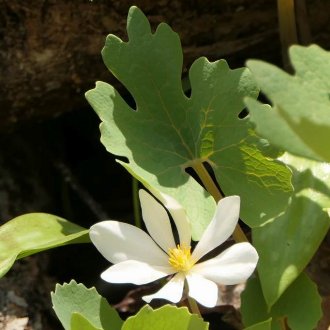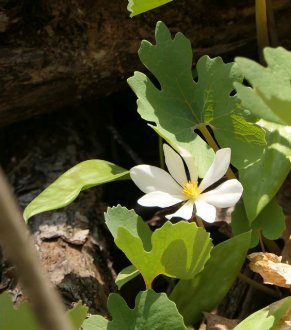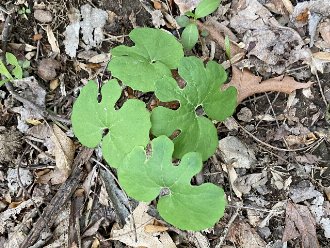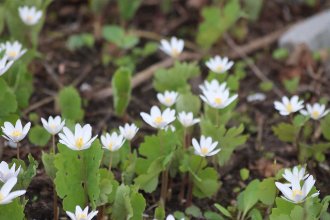Bloodroot (Sanguinaria canadensis L.)
↑Summary
An herbaceous perennial with white flowers and irregularly lobed leaves, native to woodlands in eastern North America.
↑Range - Expand
| Legend | Color |
| Native | |
| Native or Not Present |
This tentative map is based on our own research. It may have limited data on Canada and/or Mexico, and there is some subjectivity in our assignment of plants as introduced vs. expanded. Read more in this blog post.
Although this plant occurs somewhere in each of these regions, it may only occur in a small part of some or all of them.
↑Habitat
Found in rich deciduous woodlands, especially but not only on slopes. Common in much of its range and found in other habitats including well-drained portions of shaded floodplains, bluffs, and occasionally in wooded anthropogenic habitats. Found in lighting conditions ranging from an open forest canopy to deep shade so long as the shade is from deciduous trees and there is a period of higher light early in the spring before trees leaf out. Usually requires rich, well-developed and well-drained soil, but tolerates some rocky material in the soil, and in the northeastern portion of its range it can sometimes be found on rock outcroppings and talus slopes. Usually limited to sites that have not experienced recent disturbance.
↑Life Cycle
Bloodroot is a slow-developing perennial, reflecting the shaded habitats in which it develops, in which abundant light is only available for a brief period early in its growing season. It is sometimes described as a spring ephemeral, but it persists longer into the growing season than most spring ephemerals.
Each year, leaves emerge in spring before most trees tend to leaf out. Mature plants begin flowering before leaves are fully unfurled. Like other species of the poppy family, bloodroot's flowers lack nectar, but the pollen is sufficiently nutritious to attract pollinators. Blooms typically last only a few days at most. Leaves usually only unfurl after blooming is complete. At this point, trees are beginning to leaf out and the light levels on the leaves decrease. Foliage persists and often grows somewhat through the early part of the summer, but begins to die back in mid summer and is often gone by late summer. Plants can survive significant summer drought by going dormant earlier.
Seeds are primarily ant-distributed; ants are attracted to a fatty appendage on seeds, and carry it for some distance after which the seed falls off and is left to be covered with litter throughout the year. The average distance that seed travels tends to be much higher in sparse populations than in dense populations, where most seed is dropped close to the parent plants. Seeds may germinate in the subsequent spring after a period of cold dormancy, but this species is able to form a long-term persistent seed bank. However, because long-term seed banking is atypical of species with a life cycle similar to bloodroot, Albrecht (2006) proposed that the seed banking may be a "disequilibrium" situation caused by human-induced changes to the environment breaking some of the mechanisms that would normally break seed dormancy, such as the introduction of new species of ants, and that it may be due to the fact that rodents can sometimes consume large numbers of seed and rodents disproportionately consume seeds where the fatty appendage is still attached.
Seedlings are slow to establish and typically take 2-3 years, sometimes more, before they bloom. Plants continue to grow in extent for as long as 6 years.
We could not find any information about this species' lifespan in the wild, but given its occurrence in stable habitats and its slow maturity, the maximum lifespan of individual plants is likely is much longer than 6 years.
↑Faunal Associations
A wide variety of bees are attracted to the flowers to collect pollen, including honeybees, bumblebees, small carpenter bees (Ceratina sp.), the halictid bees Halictus sp. and Lasioglossum sp., and Andrena sp.. Syrphid flies and beetles also visit the flowers.
The seeds are distributed primarily by ants, and are also eaten by rodents. Introduced ant species can pose problems for this species seed distribution mechanism, because they do not necessarily distribute the seed onto as suitable sites as native ants do.
The foliage and roots are toxic to mammals and thus mostly ignored by mammalian herbivores, with deer only sparingly browsing the leaves.
The specialist aphid Linosiphon sanguinarium eats the plant's sap, from the leaf undersides. In general this plant does not support many Lepidoptera and is likely not the preferred host to any Lepidoptera, but larvae of two generalist moths, the southern armyworm (Spodoptera eridania), and the tufted apple bud moth (Platynota idaeusalis) have been recorded eating it.
↑Uses
Bloodroot is sometimes cultivated as an ornamental plant in shaded gardens, where it is valued for its flowers, although short-lived, and its distinctive foliage, as well as its tolerance of shade and resistance to browsing by deer and rabbits. There are some cultivars available, including double-flowered forms; double flowers on this species result from selection to modify stamens into petal-like structures; such structures block pollination and reduce the ecological value of this plant, so such cultivars are best avoided.
The root has found a number of medicinal uses, both historical use by Native Americans, and use in contemporary herbalism. The uses most supported by evidence are its antibacterial properties; it has been included in natural toothpastes for antiplaque properties, and also to treat gingivitis. However, its use for these purposes may not be safe, and it has been linked to causing precancerous lesions. There has been some suggestive use that certain compounds may have useful properties for heart health, including lowering of blood pressure, antiplatelet effects, or inotropic effects, but this use has not been thoroughly investigated in a clinical setting. In general, the plant is known to carry significant risks and has not been studied enough to establish safe and effective ways to use it medicinally.
↑Related Plants
Bloodroot is the only member of the Sanguinaria genus. However, the broader Chelidonieae tribe of the Papaveroideae subfamily of the Papaveraceae (poppy) family. Within this tribe, it is closest-related to Eomecon, a genus that does not occur in North America. Of the plants found here, it is closest-related to greater celandine (Chelidonium majus), which is an invasive plant in the northeastern US and eastern Canada.
It is slightly less closely related to the introduced plume poppy (Macleaya cordata), blackspot hornpoppy (Glaucium corniculatum), and yellow hornpoppy (Glaucium flavum), and the native celandine poppy (Stylophorum diphyllum), which is the native species to which it is most closely related.
↑Links & External Resources
• Sanguinaria canadensis (Bloodroot) | Illinois Wildflowers (About This Site)
• Sanguinaria canadensis (bloodroot) | USDA PLANTS Database (About This Site)
• Sanguinaria canadensis | Go Botany (About This Site)
• Sanguinaria canadensis (Bloodroot) | Missouri Botanical Garden Plant Finder (About This Site)
• Sanguinaria canadensis | Biota of North America Project (BONAP) (About This Site)
• Bloodroot: Benefits, Uses, Precautions, and Dosage | Healthline (About This Site)
• Sanguinaria canadensis L. | Plants of the World Online (POWO) (About This Site)
• Sanguinaria canadensis | NatureServe Explorer (About This Site)
• Sanguinaria canadensis | Flora of North America (About This Site)
• Sanguinaria canadensis | Missouri Plants (About This Site)
• Bloodroot | Maryland Biodiversity Project (About This Site)
• Sanguinaria canadensis (Bloodroot) | Minnesota Wildflowers (About This Site)
• Sanguinaria canadensis L. (Bloodroot) | Digital Atlas of the Virginia Flora (About This Site)






